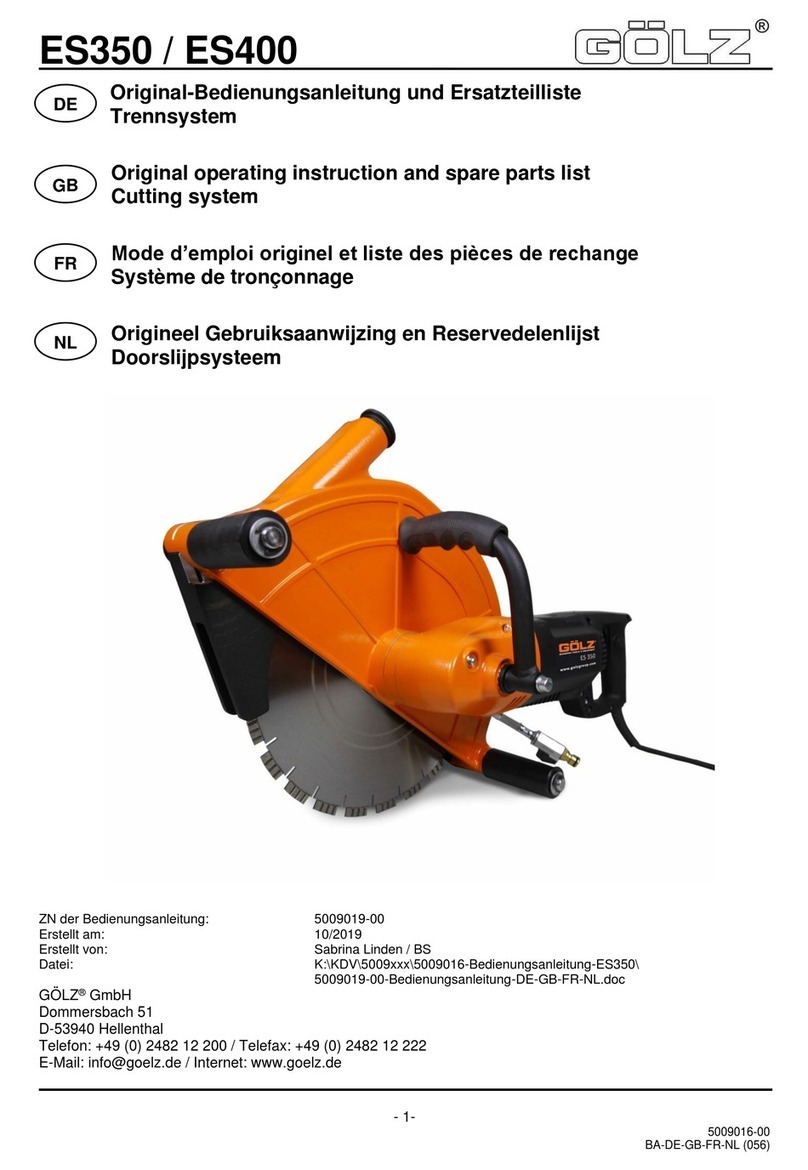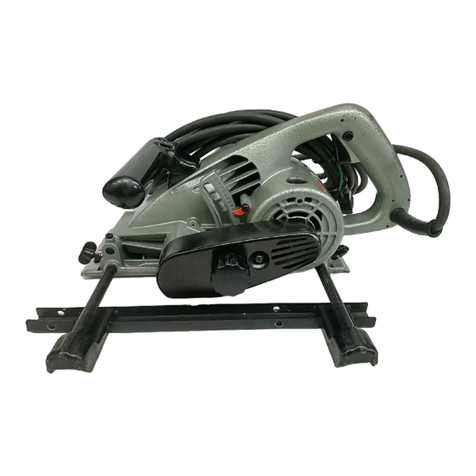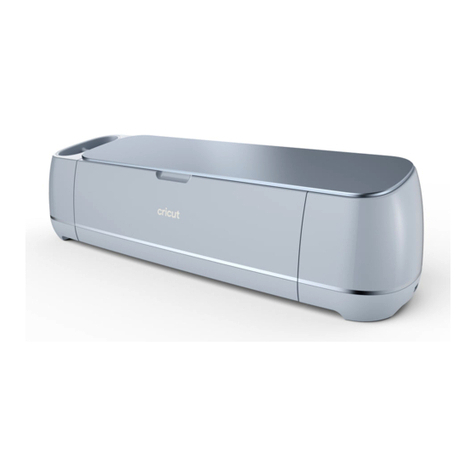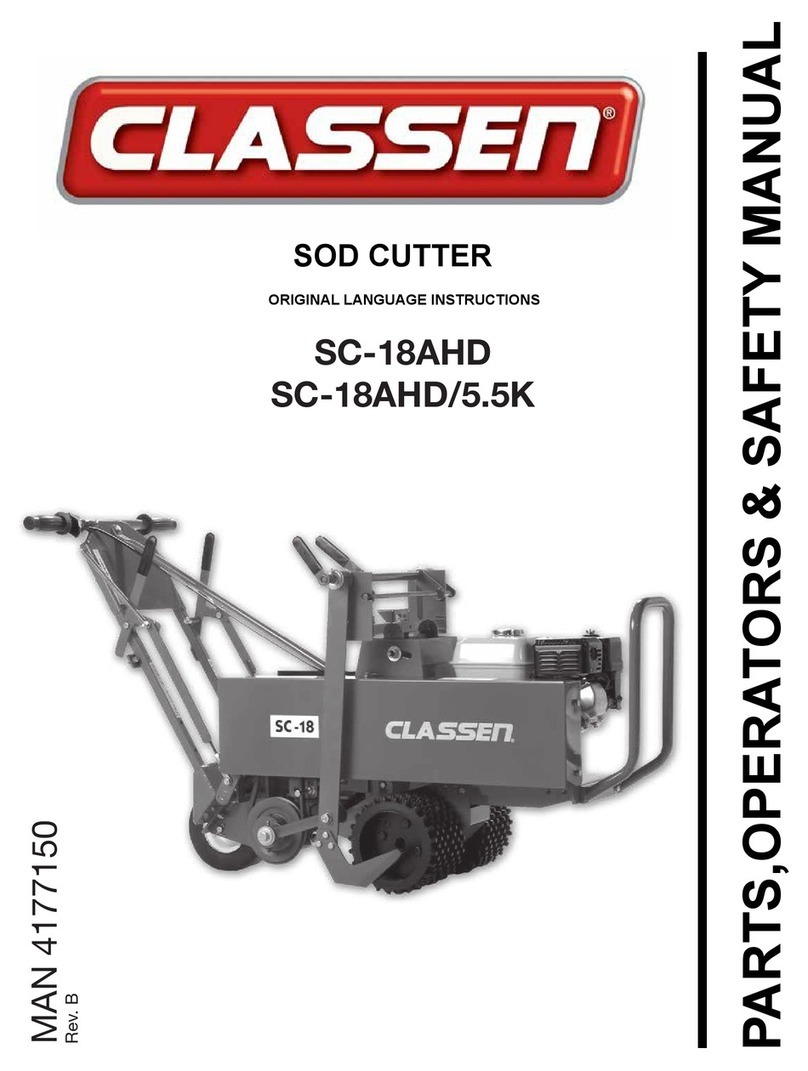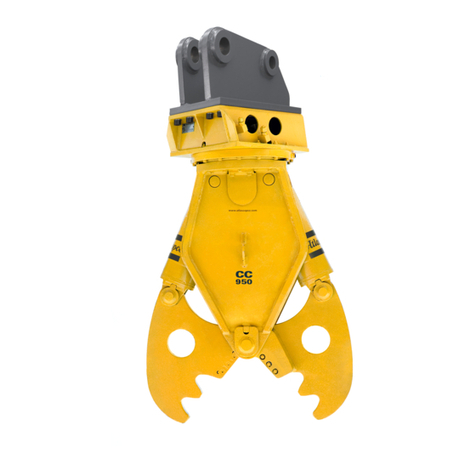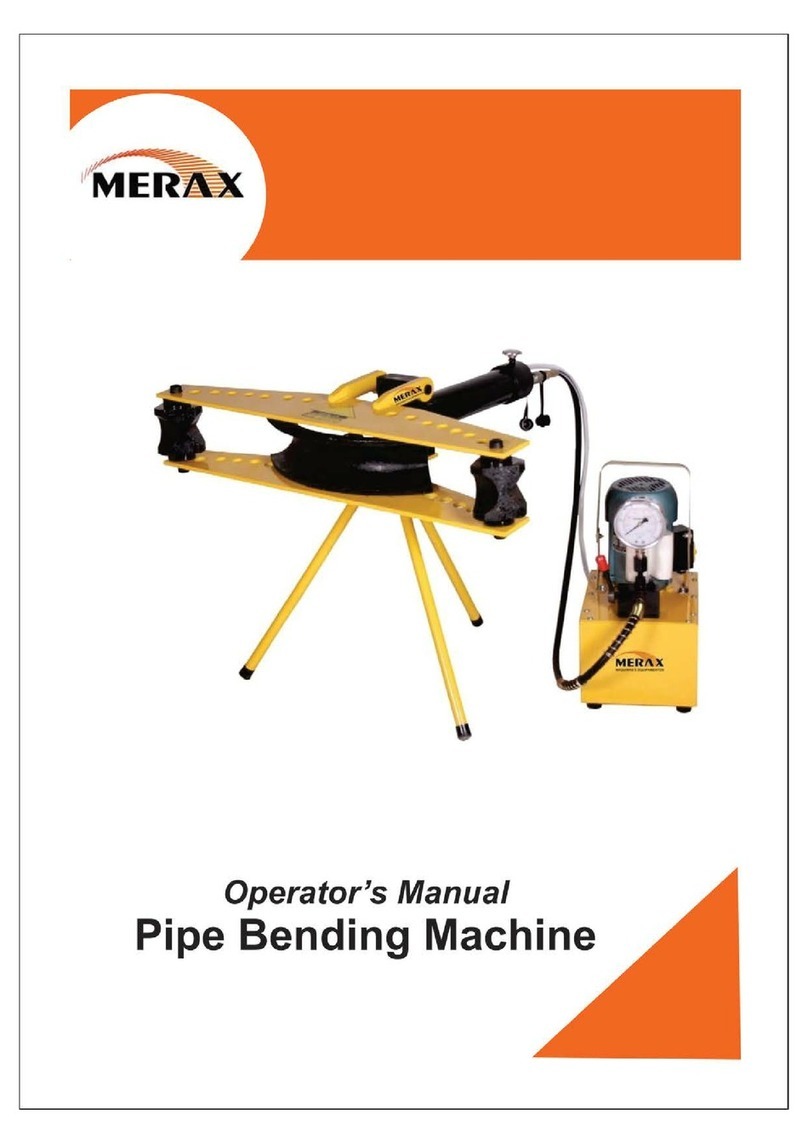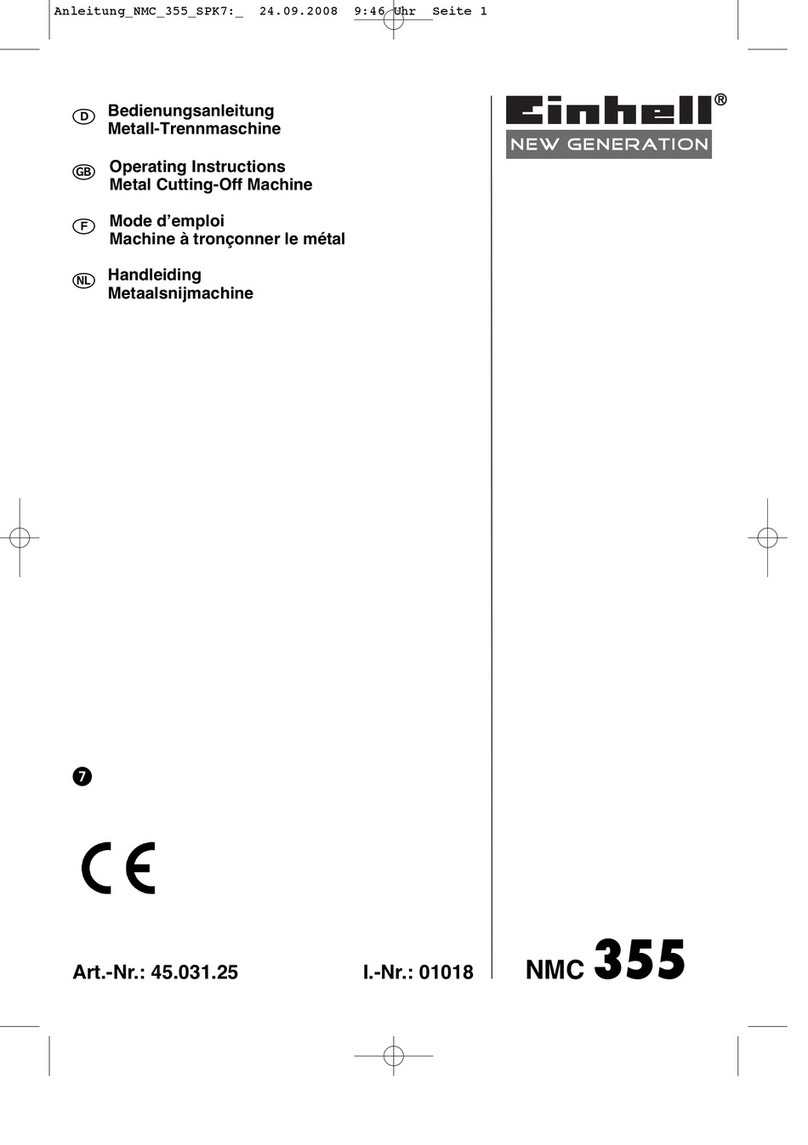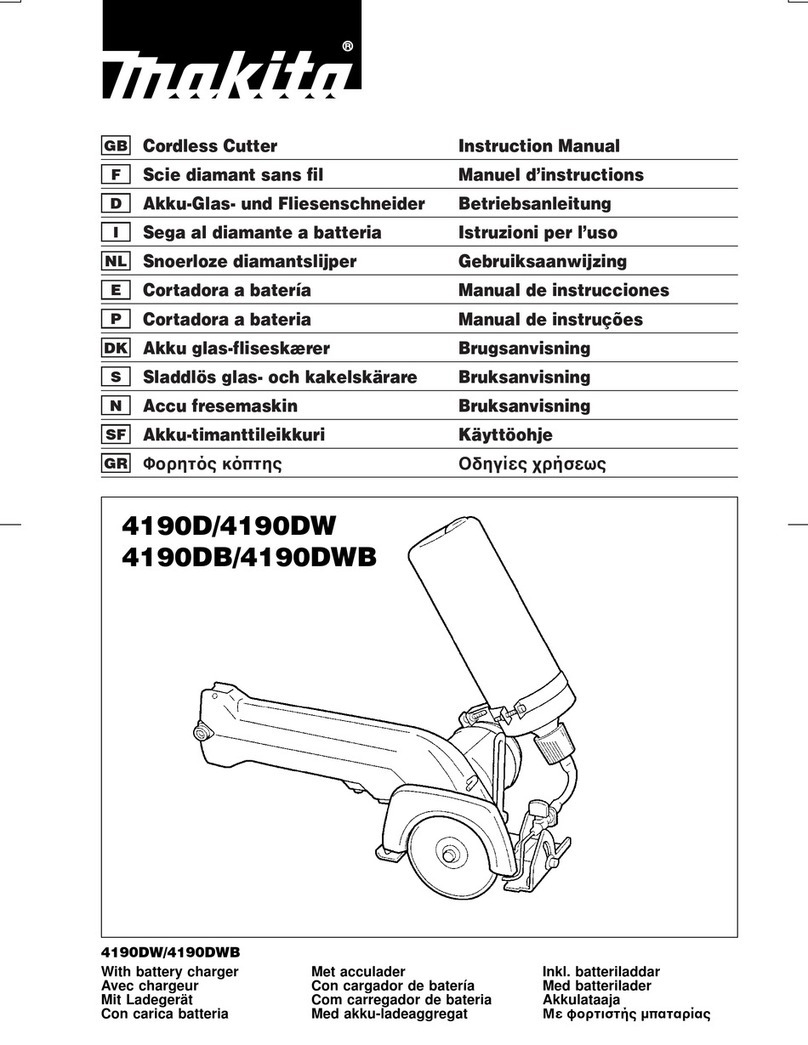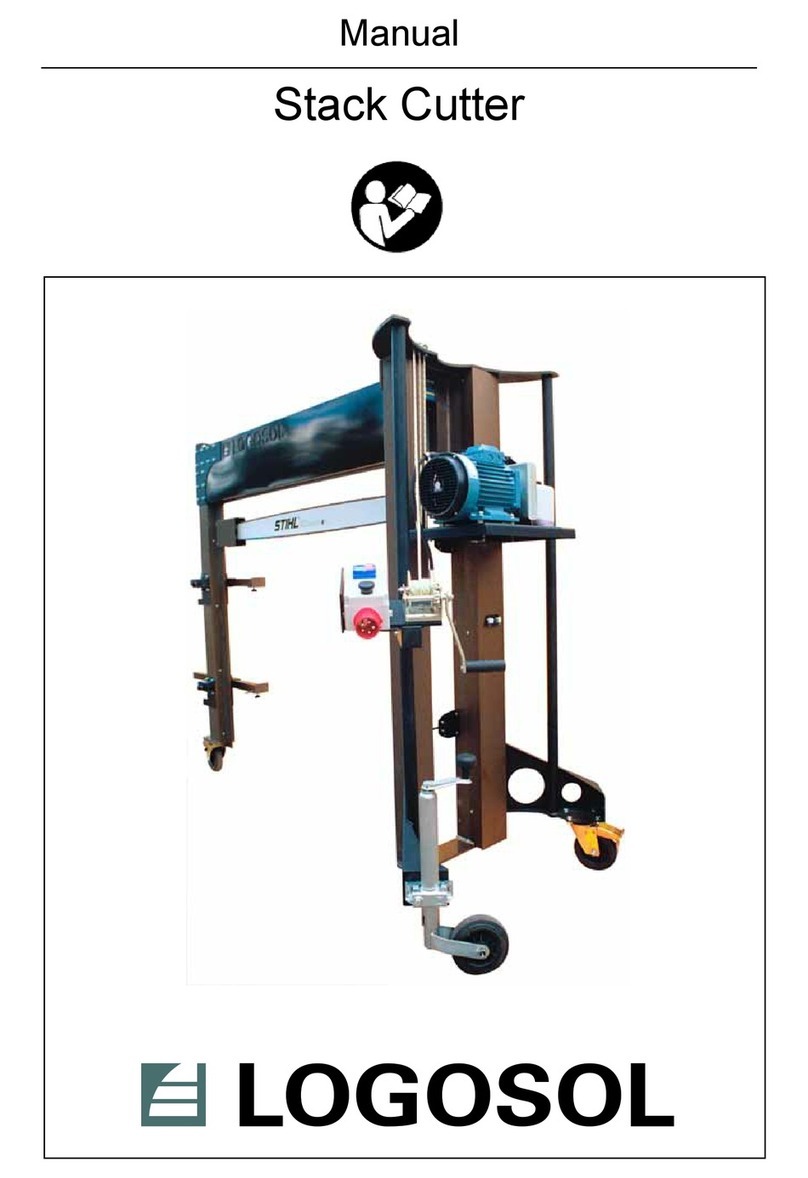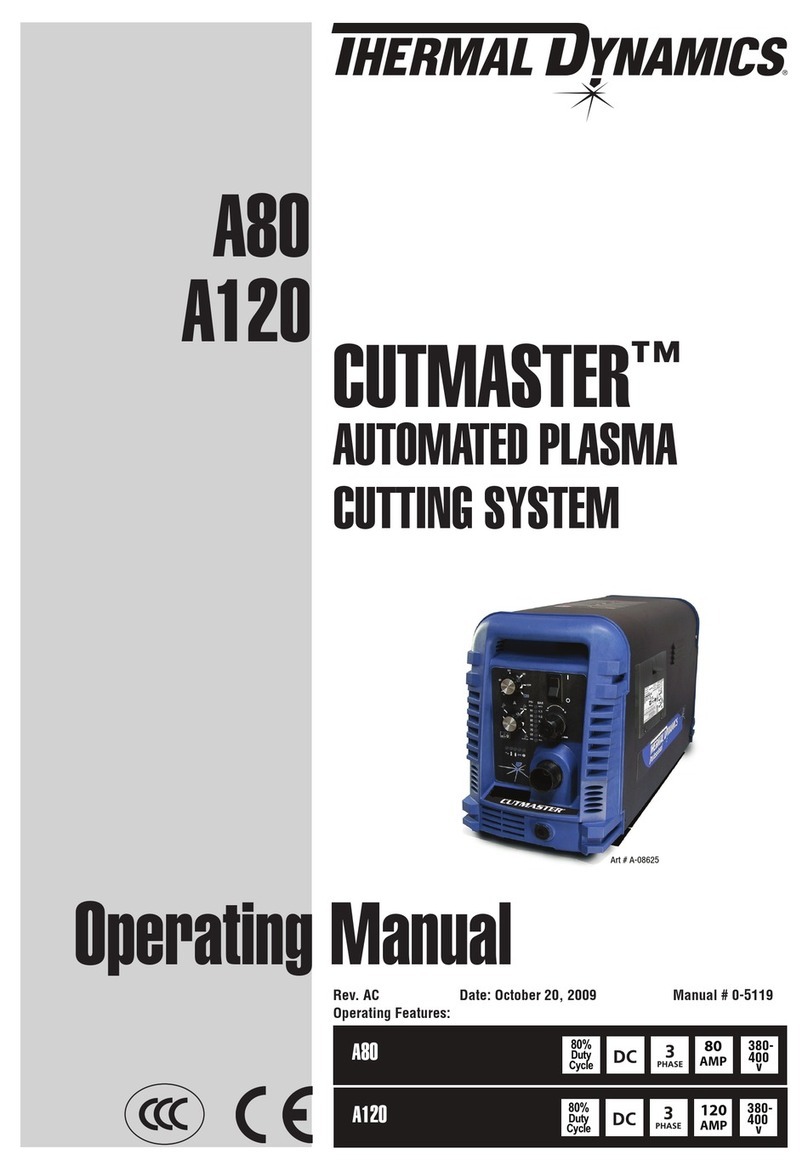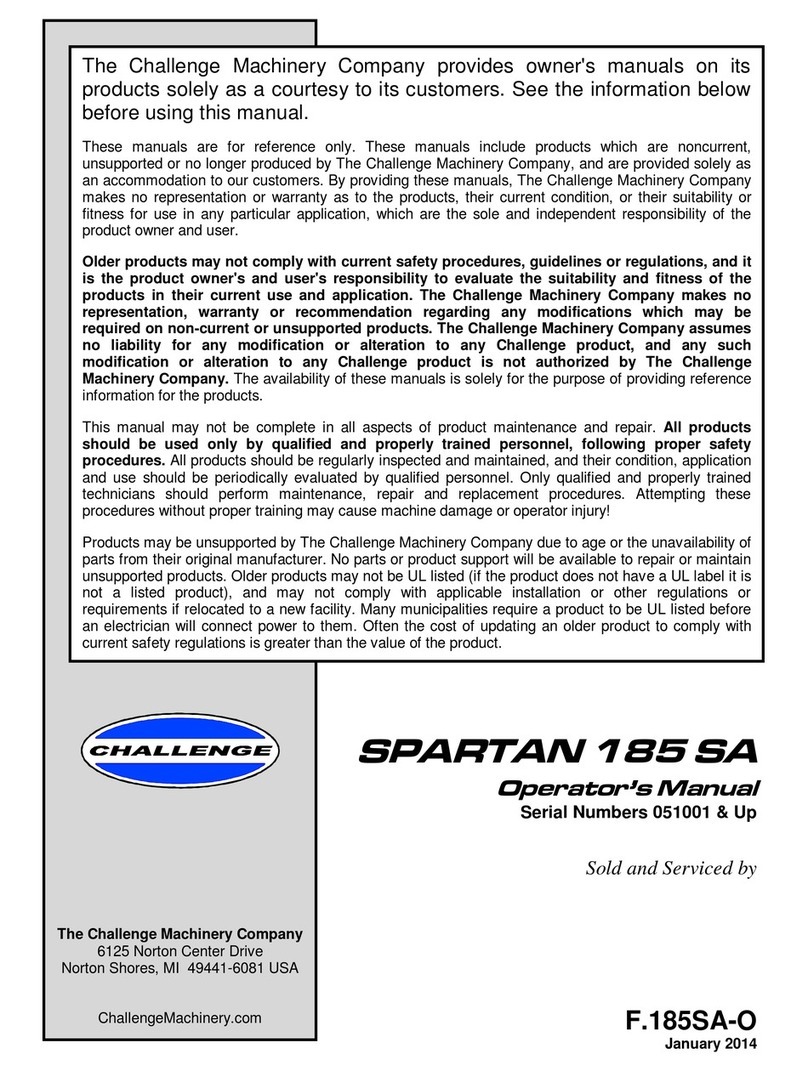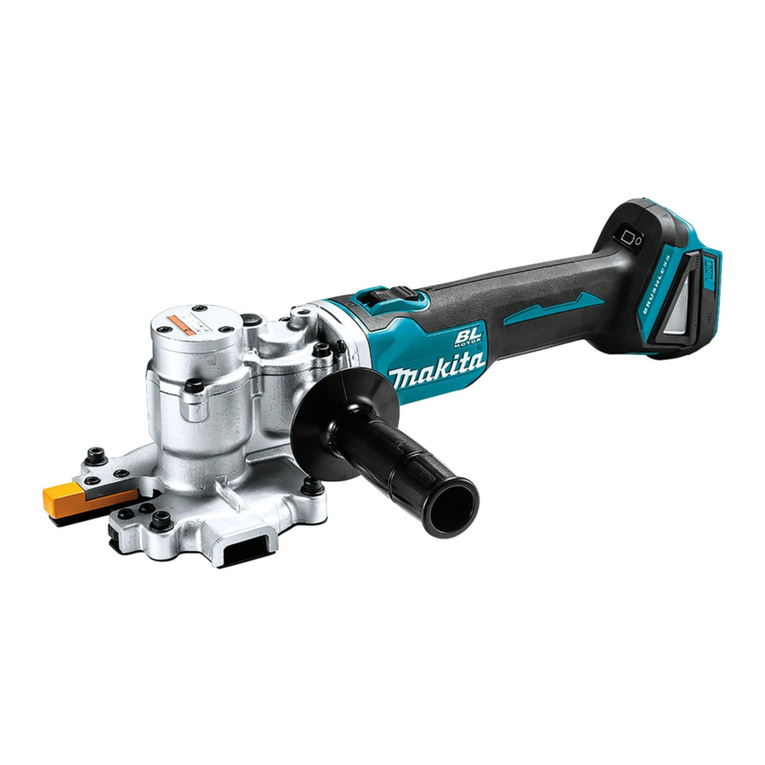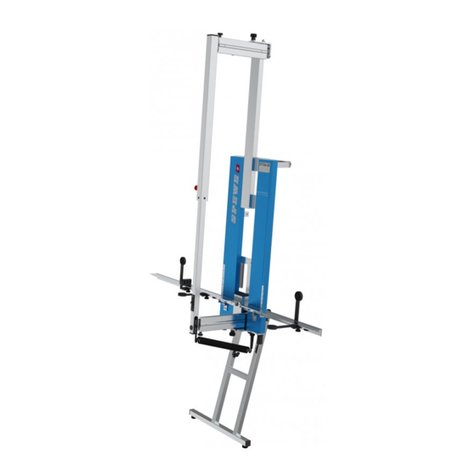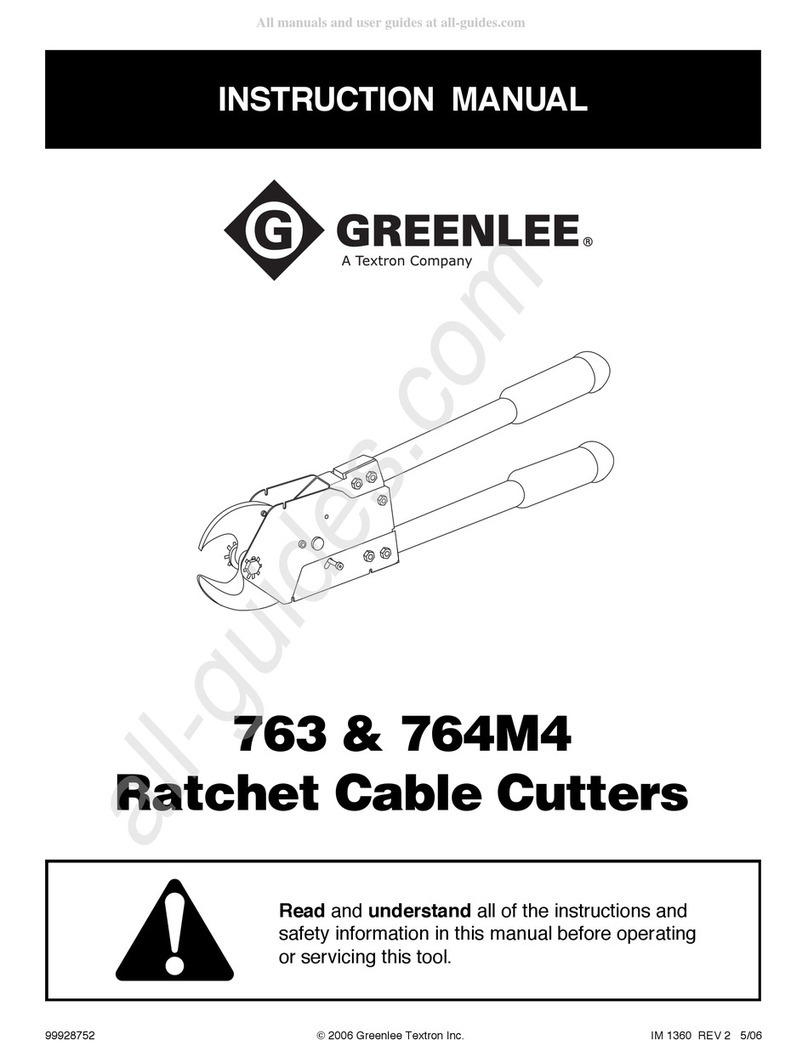GÖLZ TS250A Operational manual

1 / 73
Translation of the Original Operating Manual
Tile cutting machine – TS250A
Read operating manual before starting any work!
Keep the operating manual for future use!
(086)

2 / 73
Revision
Date Chapter Reason for change Person responsible
05-20 Reissue Design
Revision status: 05.2020
Serial number:
©
Gölz GmbH
Dommersbach 51
D- 53940 Hellenthal
Tel.: +49 (0)2482 – 12 200
Fax: +49 (0)2482 – 12 222
email: info@goelz.de
website: www.goelz.de

1 Content
3 / 73
1 Content
1
Content .........................................................................................................................................................3
2
General .........................................................................................................................................................6
2.1
Operating manual .............................................................................................................................6
2.2
Symbols, acronyms, terminology......................................................................................................6
2.3
Explanation of symbols.....................................................................................................................6
2.4
Liability limitation...............................................................................................................................7
2.5
Customer service..............................................................................................................................8
2.6
Copyright...........................................................................................................................................8
3
Safety ............................................................................................................................................................9
3.1
Intended use .....................................................................................................................................9
3.2
Rationally foreseeable misuse..........................................................................................................9
3.3
Responsibilities of the operator ......................................................................................................10
3.4
Responsibilities of the personnel....................................................................................................10
3.5
Personnel requirements..................................................................................................................11
3.6
Personal protective equipment .......................................................................................................12
3.7
Dangers ..........................................................................................................................................12
3.7.1
Risks through mechanical hazards....................................................................................12
3.7.2
Risks through electrical hazards........................................................................................13
3.7.3
Risks through thermal hazards ..........................................................................................13
3.7.4
Risks posed by special physical effects.............................................................................13
3.7.5
Risks due to hazardous substances ..................................................................................14
3.7.6
Risks due to work environment conditions ........................................................................14
3.7.7
Risks due radiation hazards ..............................................................................................14
3.8
Safety devices ................................................................................................................................14
3.9
Spare parts .....................................................................................................................................15
3.10
Actions in emergency and in case of accidents..............................................................................15
3.11
Signage...........................................................................................................................................15
4
Technical data............................................................................................................................................17
4.1
Dimensions of the machine ............................................................................................................17
4.2
Dimensions of the cut piece............................................................................................................17
4.3
Connection and motor values.........................................................................................................17
4.4
Other data.......................................................................................................................................17
4.6
Laser...............................................................................................................................................17
4.5
Water pump ....................................................................................................................................17
4.7
Noise emission ...............................................................................................................................17
4.8
Operating conditions.......................................................................................................................18
4.9
Cutting wheels ................................................................................................................................18
4.10
Type plate .......................................................................................................................................19
4.11
Installation site requirements..........................................................................................................19
4.12
Storage requirements .....................................................................................................................19
5
Design and function ..................................................................................................................................20
5.1
Scope of delivery and responsibility ...............................................................................................20
5.2
TS250A...........................................................................................................................................20
5.2.1
Functional description........................................................................................................21
6
Transport & packaging .............................................................................................................................23
6.1
Transport safety information...........................................................................................................23
6.2
Transport inspection .......................................................................................................................23
6.3
Transport symbols ..........................................................................................................................23
6.4
Transport and storage ....................................................................................................................24
7
Installation and first commissioning .......................................................................................................26
7.1
Installation safety information .........................................................................................................26

1 Content
4 / 73
7.2
Location ..........................................................................................................................................26
7.3
Connection......................................................................................................................................27
7.4
First commissioning and acceptance, general ...............................................................................27
7.4.1
Steps before commissioning..............................................................................................27
7.4.1.1
Mounting a cutting wheel .........................................................................................27
7.4.1.2
Fill the water tank.....................................................................................................28
8
Operation....................................................................................................................................................29
8.1
Operation safety information...........................................................................................................29
8.2
Intended working position of the operator ......................................................................................29
8.3
Start-up preparation........................................................................................................................30
8.5
Cutting operation ............................................................................................................................30
8.5.1
Normal cutting in 90°position ............................................................................................30
8.5.2
Cutting method: 45°bevel cuts..........................................................................................31
8.5.3
Water supply......................................................................................................................31
8.6
Stop cutting operation.....................................................................................................................32
9
Maintenance & cleaning............................................................................................................................33
9.1
Maintenance safety information......................................................................................................33
9.2
Maintenance plan ...........................................................................................................................33
9.3
Description of the maintenance works to be carried out by the operator .......................................35
9.3.1
Replacing the cutting wheel...............................................................................................35
9.3.2
Checking water supply line ................................................................................................35
9.3.3
Water pump and tank.........................................................................................................35
9.4
Steps after completing maintenance ..............................................................................................35
9.5
Parts susceptible to wear................................................................................................................36
10
Errors ..........................................................................................................................................................37
10.1
Troubleshooting safety information ................................................................................................37
10.2
Actions in case of errors .................................................................................................................37
10.3
Troubleshooting table .....................................................................................................................38
10.4
Steps after troubleshooting.............................................................................................................40
11
Dismantling and disposal .........................................................................................................................41
11.1
Dismantling and disposal safety information ..................................................................................41
11.2
Dismantling .....................................................................................................................................41
11.3
Disposal ..........................................................................................................................................41
12
Spare parts list...........................................................................................................................................43
12.1
Using the spare parts list ................................................................................................................43
12.2
Distribution agencies ......................................................................................................................43
12.3
Exploded view and spare parts list .................................................................................................45
12.3.1
Machine .............................................................................................................................45
12.3.2
Main frame .........................................................................................................................46
12.3.3
Guiding bridge....................................................................................................................50
12.3.4
Motor support.....................................................................................................................52
12.3.5
Cutter head ........................................................................................................................54
12.3.6
Main pillar...........................................................................................................................56
12.3.7
Cutting table aluminium version.........................................................................................57
12.3.8
Cutting table steel version .................................................................................................58
12.3.9
Back square .......................................................................................................................59
12.3.10
Blade guard........................................................................................................................60
12.3.11
Water tank..........................................................................................................................62
12.3.12
Transport wheel .................................................................................................................64
12.3.13
Transport handle................................................................................................................65
12.3.14
Laser ..................................................................................................................................66
12.4
Optional accessory .........................................................................................................................67
12.4.1
Lateral extension................................................................................................................67
12.4.2
T-Lock tile clamp................................................................................................................68
12.4.3
Long guider ........................................................................................................................69

1 Content
5 / 73
13
Wiring diagram...........................................................................................................................................70
14
Index ...........................................................................................................................................................71
EU conformity declaration.............................................................................................................................73

2 General
6 / 73
2 General
2.1 Operating manual
This operating manual provides guidance on safe and efficient operation and should form a basis of
any actions involving the machine. It is an integral part of the machine, which should be kept in the
immediate vicinity accessible for its operating personnel.
Prerequisite of safe operation is adherence to all safety and handling instructions.
Therefore, before starting any work, the personnel must read carefully and understand the operating
manual.
Moreover, the accident prevention regulations applicable at the site of the machine operation and
general safety regulations must be complied with.
2.2 Symbols, acronyms, terminology
Symbols, acronyms and specialist terminology used in this document have the following meaning:
See item
Enumeration
- Enumeration
1 Position number
1. Action step
Text in italics Explanation of facts
Refers to the document contained in the enclosed documentation. The source of
the document is specified in italics behind the symbol.
2.3 Explanation of symbols
Warnings and safety instructions
Warnings and safety instructions in the manual are identified with the pictograms and provided in
blocks highlighted in grey.
Warnings and safety instructions, which draw attention to fundamental dangers, are additionally
preluded by signal words, which specify the scope of damage. Their structure is as follows:
All warnings and safety instructions must be implicitly complied with!
During the works, always act with caution, to avoid accidents, personal and material damage!
Pictograms combined with signal words mean:
SIGNAL WORD!
Origin of the danger.
Consequences of ignoring the danger.
- Actions to avoid danger
DANGER!
... draws attention to an immediate danger that, if not avoided, may result in heavy or even fatal
injuries.

2 General
7 / 73
Tips and recommendations
Special safety instructions
To make aware of special dangers, the following pictograms are used in combination with the safety
instructions:
2.4 Liability limitation
All data and instructions provided in this manual were compiled with consideration of applicable
standards and regulations, state of the art in this field and our long-standing insights and
experience.
The manufacturer accepts no liability for damages caused by:
Non-observance of the Operating manual
Unintended use
Employment of unskilled and uninstructed personnel
NOTE!
… highlights tips and recommendations as well as information on efficient and trouble-free
operation.
… marks danger due to electric current.
Failure to observe the safety instructions leads to danger of heavy or fatal injuries.
… marks danger of crushing.
Failure to observe the safety instructions leads to danger of heavy injuries from moving parts.
… marks danger due to hot surface.
Failure to observe the safety instructions leads to danger of burns and heavy skin injuries caused
by heat.
… marks danger from moving cutting wheels.
Failure to observe the safety instructions leads to danger of cuts and heavy skin injuries caused
by rotating cutting wheels.
WARNING:
... draws attention to potentially dangerous situations that, if not avoided, may cause heavy or
even fatal injuries.
CAUTION!
... draws attention to potentially dangerous situations that, if not avoided, may result in slight
injuries.
ATTENTION!
... draws attention to potentially dangerous situations that, if not avoided, may result in material
damage.

2 General
8 / 73
Unauthorised conversions
Technical changes
Use of non-approved spare parts
The responsibilities agreed in the delivery contract, the General Terms and Conditions as well as the
delivery conditions of the manufacturer and the statutory regulations valid at the time of the
conclusion of the contract shall apply.
Warranty
The manufacturer guarantees the functional capability of the applied process technology and
performance parameters identified.
The warranty period commences with the defect-free delivery.
Wear parts
Wear parts are all parts having direct contact with the processed or machined material during normal
operation.
These parts are excluded from warranty and defect claims, insofar as tear and wear resulting from
normal operation.
Service life warranty
Service life warranty is granted for wear parts for the period of 6 months from the acceptance of the
defect-free product.
Warranty conditions
12 months after delivery of mechanical and electrical components for one-shift operation, except for
the wear parts and tools.
The warranty claim expires, if the system was not installed and started up by our experts.
The warranty extends to the replacement parts.
Consequential damages are excluded.
Damage caused by natural wear, deficient of improper maintenance, failure to comply with the
operating regulations, excessive loads and use of inappropriate equipment shall be excluded from
the warranty.
2.5 Customer service
Our customer service department is available to provide technical information.
You can obtain tips via the regional competent contact person by phone or via fax, email or website
at any time.
Moreover, our employees are interested in new information and experience arising from use and
which can be valuable for the improvement of our products.
2.6 Copyright
This document is protected by copyright. An unauthorised transfer to third parties, duplication of any
kind, including in parts, as well as use and/or disclosure of the content without written permission of
the publisher is prohibited.
Non-compliance with this provision is subject to damages. The right for further claims remains
reserved.
Service
hotline
02482 – 12 200

3 Safety
9 / 73
3 Safety
This section provides an overview of all safety aspects of protection of operators and users from
potential dangers, and safe and trouble-free operation.
Disregarding these handling instructions, warnings and safety instructions may pose serious risks.
3.1 Intended use
The TS 250A tile cutting machine is designed exclusively for the following purposes in the
commercial sector:
Any claims for damages resulting from unintended use are excluded.
The operator alone is responsible for all damages due to unintended use.
3.2 Rationally foreseeable misuse
Any use of the machine going beyond the intended one, shall be deemed unintended and thus
prohibited.
This also applies to:
cutting unauthorised construction materials, e.g., timber, metals, plastics
cutting any materials other than presented
cutting without or with open cutting wheel guard
cutting without water
removal of clippings in pendulum cutting procedure (vertical plunging into chippings from
above)
The T
S
250
A
tile cutting machine
is designed for wet cutting of the solid construction materials such as:
Tile, ceramic and marble
WARNING:
Risk of unintended use!
Any use beyond the intended use of the machine may result in dangerous situations.
- The machine must be basically used for the intended purpose according to data
contained in this document, in particular, within the application limits provided in the
technical data.
- Refrain from any use beyond this scope or different use of the machine.
- Refrain from remodelling, refitting or changing the design or separate parts of the
machine for the purpose of changing the field of application or applicability of the
machine.
WARNING:
Risk of injury caused by misuse!
When misused, the machine may create dangerous situations for persons and cause heavy
material damage.
- Refrain from any misuse of the machine.

3 Safety
10 / 73
3.3 Responsibilities of the operator
Operator
An operator is every natural or legal person, who uses the machine or delegates its use to others
and is responsible for the safety of the user, personnel or third parties in the course of such use.
Operator's duties
The machine is used in the commercial sector. Therefore, the operator of the machine is subject to
statutory obligations regarding occupational safety.
In addition to the warnings and safety instructions in this manual, the occupational safety, accident
prevention and environmental protection regulations applicable to the field of the machine operation
must be adhered to.
The operator, in particular, must:
be informed about current occupational safety regulations,
determine, through hazard evaluation, any potential additional dangers resulting
from specific usage conditions at the site of the machine operation,
put necessary behavioural requirements of the operating instructions into practice during the
machine tool operation at the operation site,
check regularly throughout the service life of the machine, whether the operating instructions
drawn up by the operator are in line with the current status of rules and regulations,
adjust the operating instructions, where necessary, to the new regulations, standards and
operating conditions,
exercise control of the competence for installation, operation, maintenance and cleaning of the
machine in a clear and unambiguous manner,
make sure that all personnel involved with the machine have read and understood the operating
instructions. Moreover, the personnel must undergo training in handling the machine at regular
intervals and be informed about potential dangers,
provide the persons appointed for operating the machine with the prescribed and recommended
protective devices.
Moreover, the operator is responsible for ensuring that the machine
is always in a technically perfect condition,
is maintained according to the specified maintenance intervals, and
that all safety mechanisms of the machine are regularly controlled for completeness and
functionality.
3.4 Responsibilities of the personnel
The machine is in the commercial use. Therefore, the personnel are subject to statutory obligations
regarding occupational safety.
In addition to the warnings and safety instructions in this manual, the occupational safety, accident
prevention and environmental protection regulations applicable to the field of operation must be
adhered to.
In particular, the personnel must:
be informed about current occupational safety regulations,
adhere to behavioural requirements set out in the operating instructions issued at the site of the
machine operation,
properly exercise the responsibilities entrusted to them as regards installation, operation,
maintenance and cleaning of the machine,
fully read and understand the operating manual before starting work,
use the prescribed and recommended protection equipment,

3 Safety
11 / 73
Moreover, scope of responsibility of every person operating the machine includes the duty of always
keeping it in a technically perfect condition,
performing maintenance, according to the intervals specified,
controlling all safety mechanisms for completeness and functionality on a regular basis.
3.5 Personnel requirements
Fundamentals
Any operation with the machine may only be carried out by the persons, capable of performing their
work properly and reliably and meet every requirement mentioned.
No works can be carried out by the persons, whose response capability is affected, e.g., by
drugs, alcohol or medicines.
When deploying personnel at the site of operation, always adhere to the applicable occupational
and age-specific regulations.
Qualification
Instructed personnel
Instructed personnel are the persons, who have been instructed by the operator on the tasks to be
carried out and potential dangers in a detailed and verifiable way.
Specialist personnel
Specialist personnel are the persons, who, due to their professional training, knowledge and
experience, as well as knowledge of the relevant provisions, are capable of duly carrying out the
works assigned, recognise potential dangers independently and avoid personal and material
damage.
Qualified electricians
As a matter of principle, all works on the electrical installations must be carried out by qualified
electricians.
Qualified electricians are the persons, who, due to their specialist training, knowledge and
experience, as well as knowledge of the relevant provisions, are capable of duly carrying out the
works on electrical systems, recognising potential dangers independently and avoiding personal and
material damage caused by electric current.
Unauthorised persons
WARNING:
Risk of injury for unqualified personnel!
Improper operation can result in significant personal and material damage.
- Any operations must be only carried out by the persons having required training,
knowledge and experience.
-
WARNING:
Danger of injuries for unauthorised persons!
Those who have not been instructed are not aware of the dangers in the area of operation and
must be considered unauthorised persons.
- Keep unauthorised persons away from the area of operation; if in doubt, address the
persons met and banish them from the area of operation.
-
Suspend operations until
unauthorised
persons
leave the area of operation.

3 Safety
12 / 73
3.6 Personal protective equipment
Wearing personal protective equipment is required during the work.
3.7 Dangers
The machine has undergone a risk review. Wherever possible, the identified dangers were
eliminated and risks reduced. Nevertheless, the machine poses residual risks described in the
following section.
Strictly observe warnings and safety instructions specified here and in the chapters about
handling to avoid potential damage to health and dangerous situations.
3.7.1 Risks through mechanical hazards
Rotating tools
Flying clippings / tool
(1) Helmet with ear protectors
(2) Visor or protective goggles
(3) Dust mask / respirator
(4) Safety gloves
(5) Suitable protective clothing
(6) Protective footwear with protection
NOTE!
It is prohibited to wear protective gloves near rotating parts, which pose the danger of pinching.
Here, danger created by wearing protective definitely surpasses the intended protection.
CAUTION!
Risk of cut injuries!
Reaching into rotating tools may lead to heavy injuries.
- Do not touch rotating cutting wheels in any circumstances
- Never work without cutting wheel guard.
- Only work with cutting wheel guard closed
- Only remove clippings with cutting wheel stopped.
CAUTION!
Risk of injury by flying clippings or tool parts!
Failure to wear appropriate protective equipment, working with open cutting wheel guard or with
inappropriate cutting wheels may lead to heavy injuries.
- Wear protective goggles
- Only work with cutting wheel guard closed
- Only work with cutting wheels, specifically designed for the material to be cut

3 Safety
13 / 73
Movable parts
3.7.2 Risks through electrical hazards
Electric current
3.7.3 Risks through thermal hazards
Hot surfaces
3.7.4 Risks posed by special physical effects
CAUTION!
Risk of injury by pinching in movable parts!
Failure to wear appropriate protective equipment may lead to heavy injuries.
- Wear protective gloves
- Lock the cutter head
- Lock the guiding bridge
DANGER!
Danger to life from electric current!
Touching live parts leads to death. Damaged insulation or individual components can be life-
threatening.
- Disconnect the machine from the power supply before any work on the electric system.
Verify that the system is disconnected from power supply.
- Switch off power supply before maintenance, cleaning and repair operations and secure
the machine against being restarted.
- If the power supply insulation is damaged, switch off immediately and arrange for repairs.
- Never bypass or disable fuses.
- Always use fuses with correct amperage when replacing defective fuses.
- Keep moisture away from live parts.
- Any works on the electrical installations must be carried out by qualified electricians.
CAUTION!
Risk of burns on hot surfaces.
Contact with hot parts may cause burns.
- Do not touch the surface.
- Before every work, make sure that the parts have cooled down to the ambient
temperature.
CAUTION!
Danger of injuries caused by special physical effects
Failure to wear appropriate protective equipment may lead to heavy injuries.
- Wear ear protectors
- Wear protective gloves
- Take adequate breaks
- Regular medical examinations ‘G20‘

3 Safety
14 / 73
3.7.5 Risks due to hazardous substances
3.7.6 Risks due to work environment conditions
3.7.7 Risks due radiation hazards
3.8 Safety devices
Emergency stop switch
By pressing the emergency stop switch the machine is switched off (voltage free). Power supply is
retained up to the switch. De-energize the machine by pulling out the mains plug.
After an emergency stop and before switching on again eliminate the error that has occurred.
Emergency stop
CAUTION!
Risk of injury by hazardous substances, such as dust and cutting water or slurry!
Failure to wear appropriate protective equipment may lead to damage to health.
- Use personal protective equipment
- Renew the cutting water regularly
- Use the dust mask
- Connect water supply
CAUTION!
Risk of injury due to inadequate lighting.
Work in inadequate lighting conditions may lead to heavy injuries.
- Provide for adequate lighting at the workplace.
CAUTION!
Risk of injury due optical radiation.
Looking directly into the laser beam may lead to damage to health.
-
Do not look directly into the laser beam
WARNING:
Danger to life due to defective or bypassed safety devices!
Inoperable, bypassed or disabled safety devices do not protect from hazards and may lead to
heavy or fatal injuries.
- Before commencement of works, always make sure that all safety devices are properly
installed and functional.
- Never disable safety devices.
- Ensure that the safety devices are always freely accessible.
NOTE!
See safety devices in "Design and function".

3 Safety
15 / 73
3.9 Spare parts
Original spare parts can be obtained via an authorised dealer or directly from the manufacturer.
3.10 Actions in emergency and in case of accidents
Necessary actions
Always be prepared for accidents or fire.
First aid facilities (first aid box, cloth, etc.) and fire extinguisher must be close at hand.
Personnel must familiarise themselves with accident signalling equipment, first aid and rescue
facilities.
Access roads for rescue vehicles must be always kept free.
If the need arises, act properly
Activate emergency stop immediately
Initiate first aid measures
Remove persons affected from the danger area.
Inform persons responsible at the operation site.
Alert doctor and/or fire brigade in case of heavy injuries.
Keep access roads for rescue vehicles free.
3.11 Signage
Danger from electric current!
WARNING:
Risk of injury due to wrong spare parts.
Wrong spare parts can seriously compromise safety and cause damage and malfunction up to
total failure.
- As a matter of principle, only original spare parts must be used.
DANGER!
Danger to life from electric current!
Touching live parts leads to death. Damaged insulation or individual parts can be life-threatening.
- Disconnect the machine from the power supply before any work on the electric system.
Check that no voltage is present!
- Switch off power supply before maintenance, cleaning and repair operations and secure
the machine against being restarted.
- If the power supply insulation is damaged, switch off immediately and arrange for repairs.
- Never bypass or disable fuses.
- Always use fuses with correct amperage when replacing defective fuses.
- Keep moisture away from live parts.
- Any works on the electrical installations must be carried out by qualified electricians.
- Annual check of the electric system according to VDE0701.

3 Safety
16 / 73
Danger of cutting damage
Illegible signs
There are the following symbols and information signs on the machine that refer to potential dangers:
Warning of rotating tool!
Running direction of the saw
blade
Wear gloves
Wear ear protectors
The machine meets EU
guideline
Observe the operating manual
Wear protective goggles
Laser class:II
Wavelength: 635nm
Attention!
do not stare into laser beam
CAUTION!
Risk of cut injuries!
Reaching into moving tools may lead to heavy injuries.
- Do not touch rotating cutting wheels in any circumstances
- De-energise the machine before replacing the cutting wheel
CAUTION!
Risk of injury due to illegible symbols!
Stickers and signs that got illegible, make danger zones insufficiently recognisable and may
become incapable of indicating potential injury risks.
- Always maintain legibility of pictograms, safety, warning and operating instructions.
- Immediately replace the pictograms, labels, signs or stickers that became illegible.

4 Technical data
17 / 73
4 Technical data
4.1 Dimensions of the machine
Specification Value
Unit
Specification Value
Unit
Length
1640 mm
max. length
1300 mm
Width
540 mm
max. width
600 mm
Height
1299 mm
max. height
50 mm
Empty weight
72 kg
max. weight
10 kg
Operating weight
95 kg
4.3 Connection and motor values
Specification Value
Unit
Specification Value
Unit
Rated voltage
230
V
Water tank
20
l
Rated frequency
50
Hz
Cutting wheel
250
mm
Capacity 1,3
kW
Bore
25,4
mm
Required fuse 16
A Flange Ø
Cutting shaft rotation speed 2800
U/min EU 64
mm
Motor protection class IP55
Outside EU 115
mm
Motor duty type S6
Vibration level 2,3
m/s
2
Measuring tolerance
Vibration level
0,2
m/sec^2
4.5 Water pump
Specification Value
Unit
Specification Value
Unit
Rated voltage 230 V
Capacity
1 mW
Rated frequency
50 Hz Rated current, max. 50 mA
Capacity
55 W
Rated voltage 3-6
V DC
Duty type
S2 Wavelength 635 nm
Pulse duration continuous
Class II
Protection class III
4.7 Noise emission
Without load
Full load
Measuring tolerance
Sound pressure level 73 dB (A) 89 dB (A) Sound pressure level 4 dB (A)
Sound power level 75 dB (A) 91 dB (A) Sound power level 2,5 dB (A)
Guaranteed sound
power level 85 dB (A)
The data define the sound level of the noise exposure at the workplace of the operator and sound power
level of the machine tool.
The emission values meet standards EN ISO 3744, EN 12418 and Directive 2005/88/EC.
4.4 Other data
4.
2
Dimensions of the cut piece
4.6 Laser

4 Technical data
18 / 73
4.8 Operating conditions
Working zone
Specification Value
Unit
Temperature range Ambient temperature 5-45
°C
Relative air humidity, maximum
60
(without condensing)
%
Conditions
Only operate the machine tool in the dust-free environment!
Avoid direct impact of dampness, dust and frost.
Do not operate in strong electric and magnetic fields!
Do not operate the machine tool in explosive atmosphere!
4.9 Cutting wheels
Cutting wheel Cutting wheel
diameter Material Number of
segments
SF20
Ø 250 mm
Tile, ceramic, stoneware, natural and artificial
stone, thin granite 5 mm
SLF10
Tile, ceramic, stoneware, thin granite, marble 10 mm
SlimFast
Ceramic, Tile, stoneware, Granit, marble 7,5 mm
NOTE!
All cutting wheels used must be designed in terms of their permissible max. cutting speed to
match the max. drive speed and intended application of the machine tool.
DANGER!
Risk of injury by defective or incorrectly mounted cutting wheels!
Wrong rotation direction and damaged cutting wheels may cause injuries of personnel!
- Check cutting wheels for broken off segments and segment pieces, segment foot cracks,
cutting wheel deformations or signs of wear before starting work.
- Pay attention to the rotation direction arrows on the cutting wheel and guard!
DANGER!
Risk of injury by unchecked or unapproved tool!
Cutting wheels or buzz saw blades that have not been checked or approved may cause injuries of
personnel!
- Before starting work, check whether a proper cutting wheel is mounted.
- Pay attention to the rotation direction arrows on the cutting wheel and guard!

4 Technical data
19 / 73
4.10 Type plate
The type plate is located on the base frame of the machine tool.
4.11 Installation site requirements
The floor surface must:
have sufficient load bearing capacity,
be slip proof,
be level.
Installation conditions
Choose the installation site as per space requirements according to the technical data.
4.12 Storage requirements
Storage conditions
As a matter of principle, the machine, its components, assemblies or parts must be only stored in the
following conditions:
do not store outdoors
store in dry and dust-free place
do not expose to aggressive media
protect from solar radiation
avoid mechanical vibrations
storage temperature range 5 to 45°C
relative air humidity, max. 60%
In case of storage for over 3 months, check general condition of all parts and packaging on a regular
basis. If necessary, renew or replace conservation materials
NOTE!
The machine is designed for use in daylight. In case of work zones with poor or no lighting,
ensure sufficient lighting of the workplace.

5 Design and function
20 / 73
5 Design and function
The machine consists of the base frame with pivotable main pillars and includes built-in systems,
motor, cutting table, cutting wheel hood with a cutting wheel, and water tank with water pump.
5.1 Scope of delivery and responsibility
The machine was developed and manufactured under sole responsibility of Gölz GmbH.
Upon transfer to the operator, the responsibility for safe handling and instruction of the personnel
passes to the operator.
The manufacturer offers training on the machine.
The scope of delivery includes the following components:
Components
Quantity
Tile cutting machine TS250A 1
Technical documentation
1
Optional accessory
Quantity
Lateral extension 1
T-Lock tile clamp 1
Long guider 1m 1
5.2 TS250A
1 Base frame 7 Transport handle 13 Adjusting handle
2 Cutter head 8 Transport wheels 14 Motor
3 Blade guard 9 Cutting table 15 Cable protector
4 Laser 10 Back square 16 Adjusting angle grip knob
5 Water tank 11 Cutter head handle 17 Transport lock
6 Main pillars 12 Plug / switch 18 Cutting wheel
1
2
3
4
5
6
7
8
9
10
11
12
13
14
15
16
17
18
Table of contents
Other GÖLZ Cutter manuals
